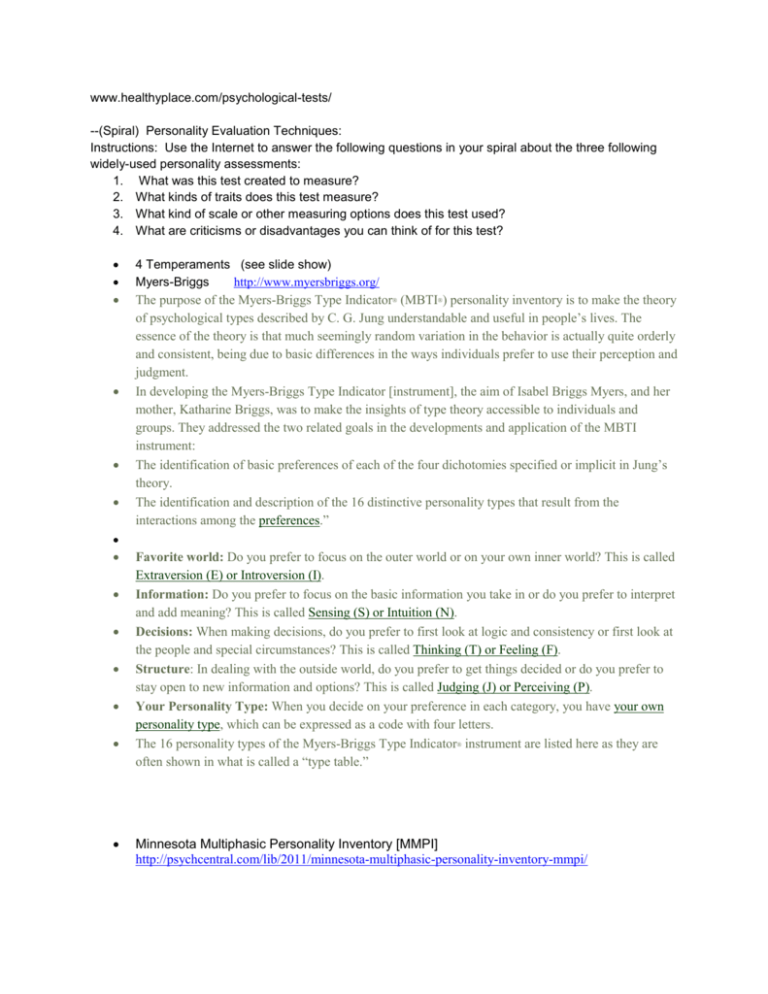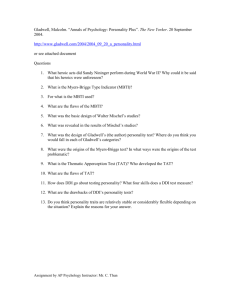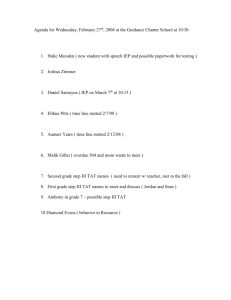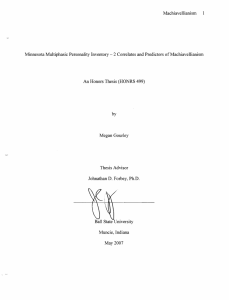What Does the MMPI
advertisement

www.healthyplace.com/psychological-tests/ --(Spiral) Personality Evaluation Techniques: Instructions: Use the Internet to answer the following questions in your spiral about the three following widely-used personality assessments: 1. What was this test created to measure? 2. What kinds of traits does this test measure? 3. What kind of scale or other measuring options does this test used? 4. What are criticisms or disadvantages you can think of for this test? 4 Temperaments (see slide show) Myers-Briggs http://www.myersbriggs.org/ The purpose of the Myers-Briggs Type Indicator (MBTI ) personality inventory is to make the theory of psychological types described by C. G. Jung understandable and useful in people’s lives. The essence of the theory is that much seemingly random variation in the behavior is actually quite orderly and consistent, being due to basic differences in the ways individuals prefer to use their perception and judgment. In developing the Myers-Briggs Type Indicator [instrument], the aim of Isabel Briggs Myers, and her mother, Katharine Briggs, was to make the insights of type theory accessible to individuals and groups. They addressed the two related goals in the developments and application of the MBTI instrument: The identification of basic preferences of each of the four dichotomies specified or implicit in Jung’s theory. The identification and description of the 16 distinctive personality types that result from the interactions among the preferences.” ® ® Favorite world: Do you prefer to focus on the outer world or on your own inner world? This is called Extraversion (E) or Introversion (I). Information: Do you prefer to focus on the basic information you take in or do you prefer to interpret and add meaning? This is called Sensing (S) or Intuition (N). Decisions: When making decisions, do you prefer to first look at logic and consistency or first look at the people and special circumstances? This is called Thinking (T) or Feeling (F). Structure: In dealing with the outside world, do you prefer to get things decided or do you prefer to stay open to new information and options? This is called Judging (J) or Perceiving (P). Your Personality Type: When you decide on your preference in each category, you have your own personality type, which can be expressed as a code with four letters. The 16 personality types of the Myers-Briggs Type Indicator instrument are listed here as they are often shown in what is called a “type table.” ® Minnesota Multiphasic Personality Inventory [MMPI] http://psychcentral.com/lib/2011/minnesota-multiphasic-personality-inventory-mmpi/ The Minnesota Multiphasic Personality Inventory (MMPI) is a psychological test that assesses personality traits and psychopathology. It is primarily intended to test people who are suspected of having mental health or other clinical issues. Although it was not originally designed to be administered to non-clinical populations, it has found The MMPI is currently commonly administered in one of two forms — the MMPI-2, which has 567 true/false questions, and the newer MMPI-2-RF, published in 2008 and containing only 338 true/false items. While the MMPI-2-RF is a newer measure and takes about half the time to complete (usually 30 to 50 minutes), the MMPI-2 is still the more widely used test because of its existing large research base and familiarity with psychologists. (Another version of the test — the MMPI-A — is designed exclusively for teenagers.) The Minnesota Multiphasic Personality Inventory is considered a protected psychological instrument, meaning it can only be given and interpreted by a psychologist trained to do so (you cannot find the test online). While it’s commonly administered by computer nowadays (and requires no direct professional involvement during its administration), psychological testing is nearly always preceded by a clinical interview by the psychologist who is doing the testing. After the computer scores the test results, the psychologist writes up a report interpreting the test results in the context of the person’s history and current psychological concerns. What Does the MMPI-2 Test? The MMPI-2 is designed with 10 clinical scales which assess 10 major categories of abnormal human behavior, and four validity scales, which assess the person’s general testtaking attitude and whether they answered the items on the test in a truthful and accurate manner. The 10 Clinical Subscales The older MMPI-2 is made up 10 clinical subscales, which are a result of answering certain questions on the test in a specific manner: 1. Hypochondriasis (Hs) – The Hypochondriasis scale tapes a wide variety of vague and nonspecific complaints about bodily functioning. These complaints tend to focus on the abdomen and back, and they persist in the face of negative medical tests. There are two primary factors that this subscale measures — poor physical health and gastrointestinal difficulties. The scale contains 32 items. 2. Depression (D) – The Depression scale measures clinical depression, which is characterized by poor morale, lack of hope in the future, and a general dissatisfaction with one’s life. The scale contains 57 items. 3. Hysteria (Hy) – The Hysteria scale primarily measures five components — poor physical health, shyness, cynicism, headaches and neuroticism. The subscale contains 60 items. 4. Psychopathic Deviate (Pd) – The Psychopathic Deviate scale measures general social maladjustment and the absence of strongly pleasant experiences. The items 5. 6. 7. 8. 9. on this scale tap into complaints about family and authority figures in general, self alienation, social alienation and boredom. The scale contains 50 items. Masculinity/Femininity (Mf) – The Masculinity/Femininity scale measures interests in vocations and hobbies, aesthetic preferences, activity-passivity and personal sensitivity. It measures in a general sense how rigidly a person conforms to very stereotypical masculine or feminine roles. The scale contains 56 items. Paranoia (Pa) – The Paranoia scale primarily measures interpersonal sensitivity, moral self-righteousness and suspiciousness. Some of the items used to score this scale are clearly psychotic in that they acknowledge the existence of paranoid and delusional thoughts. This scale has 40 items. Psychasthenia (Pt) -The Psychasthenia scale is intended to measure a person’s inability to resist specific actions or thoughts, regardless of their maladaptive nature. “Psychasthenia” is an old term used to describe what we now call obsessivecompulsive disorder (OCD), or having obsessive-compulsive thoughts and behaviors. This scale also taps into abnormal fears, self-criticisms, difficulties in concentration and guilt feelings. This scale contains 48 items. Schizophrenia (Sc) – The Schizophrenia scale measures bizarre thoughts, peculiar perceptions, social alienation, poor familial relationships, difficulties in concentration and impulse control, lack of deep interests, disturbing question of self-worth and self-identity, and sexual difficulties. This scale has 78 items, more than any other scale on the test. Hypomania (Ma) – The Hypomania scale is intended to measure milder degrees of excitement, characterized by an elated but unstable mood, psychomotor excitement (e.g., shaky hands) and flight of ideas (e.g., an unstoppable string of ideas). The scale taps into overactivity — both behaviorally and cognitively — grandiosity, irritability and egocentricity. This scale contains 46 items. 0. Social Introversion (Si) – The Social Introversion scale measures the social introversion and extroversion of a person. A person who is a social introvert is uncomfortable in social interactions and typically withdraws from such interactions whenever possible. They may have limited social skills, or simply prefer to be alone or with a small group of friends. This scale has 69 items. While there are dozens of additional content scales that have been independently developed around the MMPI-2, these are the core 10 scales used by the test. The 4 Validity Scales The MMPI-2 is not a valid measure of a person’s psychopathology or behavior if the person taking the test does so in a way that is not honest or frank. A person may decide, for whatever reasons, to overreport (exaggerate) or underreport (deny) the behavior being assessed by the test. The Minnesota Multiphasic Personality Inventory-2 (MMPI-2) contains four validity scales designed to measure a person’s test-taking attitude and approach to the test: Lie (L) – The Lie scale is intended to identify individuals who are deliberately trying to avoid answering the MMPI honestly and in a frank manner. The scale measures attitudes and practices that are culturally laudable, but rarely found in most people. In other words, people who make these items are often trying to make themselves look like a better person than they really are (or that anybody is). The scale contains 15 items. F – The F scale (the “F” does not stand for anything, although it is mistakenly sometimes referred to as the Infrequency or Frequency scale) is intended to detect unusual or atypical ways of answering the test items, like if a person were to randomly fill out the test. It taps a number of strange thoughts, peculiar experiences, feelings of isolation and alienation, and a number of unlikely or contradictory beliefs, expectations and self-descriptions. If a person answers too many of the F and Fb scale items incorrectly, it will invalidate the entire test. Contrary to some descriptions of the scale, F scale items are scattered throughout the entire test up until around item 360. The scale contains 60 items. Back F (Fb) – The Back F scale measures the same issues as the F scale, except only during the last half of the test. The scale has 40 items. K – The K scale is designed to identify psychopathology in people who otherwise would have profiles within the normal range. It measures self-control, and family and interpersonal relationships, and people who score highly on this scale are often seen as being defensive. The scale contains 30 items. There are additional content and validity scales that have been developed independently from the core MMPI, but often scored by a psychologist who is administering the test. This article describes only these core scales used in the MMPI-2. The Thematic Apperception Test [TAT]) http://www.cps.nova.edu/~cpphelp/TAT.html http://www.mentalhelp.net/poc/view_doc.php?type=doc&id=8216&cn=18 The Thematic Apperception Test, or TAT, is a projective psychological test. Historically, it has been among the most widely researched, taught, and used of such tests. Its adherents assert that the TAT taps a subject's unconscious to reveal repressed aspects of personality, motives and needs for achievement, power and intimacy, and problem-solving abilities. Procedure The TAT is popularly known as the picture interpretation technique because it uses a standard series of provocative yet ambiguous pictures about which the subject is asked to tell a story. The subject is asked to tell as dramatic a story as they can for each picture presented, including: what has led up to the event shown what is happening at the moment what the characters are feeling and thinking what the outcome of the story was If these elements are omitted, particularly for children or individuals of low cognitive abilities, the evaluator may ask the subject about them directly. There are 31 picture cards in the standard form of the TAT. Some of the cards show male figures, some female, some both male and female figures, some of ambiguous gender, some adults, some children, and some show no human figures at all. One card is completely blank. Although the cards were originally designed to be matched to the subject in terms of age and gender, any card may be used with any subject. Most practitioners choose a set of approximately ten cards, either using cards that they feel are generally useful, or that they believe will encourage the subject's expression of emotional conflicts relevant to their specific history and situation.[1] Scoring Systems The TAT is a projective test in that, like the Rorschach test, its assessment of the subject is based on what he or she projects onto the ambiguous images. Therefore, to complete the assessment, each narrative created by a subject must be carefully recorded and analyzed to uncover underlying needs, attitudes, and patterns of reaction. Although most clinical practitioners do not use formal scoring systems, several formal scoring systems have been developed for analyzing TAT stories systematically and consistently. Two common methods that are currently used in research are the: Defense Mechanisms Manual DMM[2]. This assesses three defense mechanisms: denial (least mature), projection (intermediate), and identification (most mature). A person's thoughts/feelings are projected in stories involved. Social Cognition and Object Relations SCOR [3] scale. This assesses four different dimensions of object relations: Complexity of Representations of People, Affect-Tone of Relationship Paradigms, Capacity for Emotional Investment in Relationships and Moral Standards, and Understanding of Social Causality. History TAT was developed by the American psychologists Henry A. Murray and Christiana D. Morgan at Harvard during the 1930s to explore the underlying dynamics of personality, such as internal conflicts, dominant drives, interests, and motives. According to Melville scholar Howard P Vincent, the TAT “came into being when Dr. Henry A. Murray, psychologist and Melvillist , adapted the implicit lesson of Melville’s [Moby Dick] “Doubloon” chapter to a new and larger creative, therapeutic purpose.” After World War II, the TAT was adopted more broadly by psychoanalysts and clinicians to evaluate emotionally disturbed patients.







